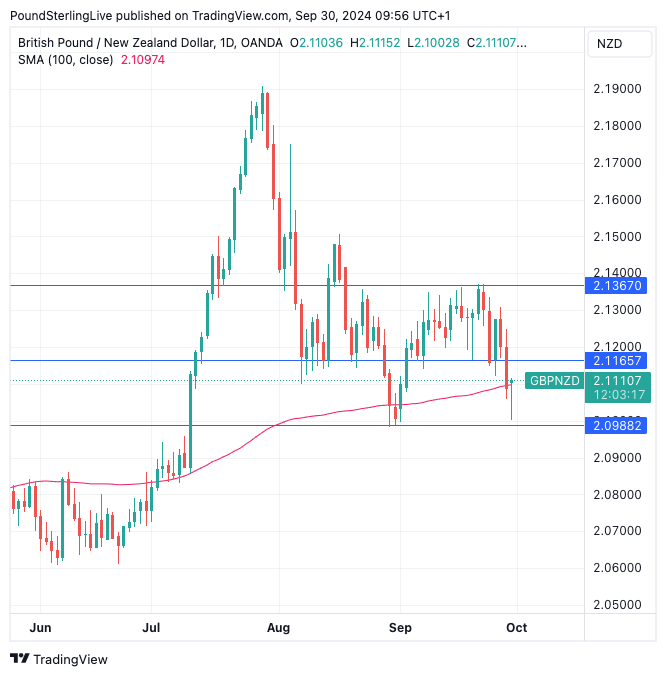Pound to New Zealand Dollar Forecast for the Week Ahead: At Risk of Technical Breakdown
- Written by: Gary Howes
-

Image © Adobe Stock
Of all the GBP exchange rates we monitor in our Week Ahead Forecast coverage, GBP/NZD is looking the most bearish.
The Pound to New Zealand Dollar exchange rate (GBP/NZD) broke to its lowest level in a month on Monday morning, having fallen to 2.10.
It has since found some buying interest, which confirms a graphical support level exists around the low:
We thus, look for support around here in the coming days, with GBP/NZD setbacks potentially finding buying interest.
The chart also shows the 100-day moving average (DMA) is in play - the red line - we will be watching to see if the exchange rate can defend a close above here as a sign that support is building.
If the pair breaks below the 100 DMA then the full suite of Week Ahead indicators are in the red, flipping the pair into a technical downtrend.
The New Zealand Dollar has proven one of the winners of the recent measures announced by China to try and boost growth, with investors seeing a boost to Asian economies particularly supportive of New Zealand's exports.
GBP/NZD investment bank consensus forecast for 2025. See the median, mean, highest and lowest targets, giving a highly accurate forecasting resource. Request your copy now.
The Kiwi is a risk-on currency, meaning that when global markets are rising it also rises. But the rule is particularly true when the global growth impulse is being driven by China.
"The package of rate cuts, and more specific support for the weak housing market and stock market has helped to boost investor confidence by highlighting that domestic policymakers are stepping up efforts to support economic growth and avoid deflation," says Lee Hardman, a foreign exchange analyst at MUFG Bank Ltd.
So, the outlook could well hinge on how much more the Chinese stimulus story has to give.
Some economists note that the latest stimulus is lacking the fiscal spending needed for a sustained boost to the economy given the lack of demand for private sector credit locally.
Sam Hill, Head of Market Insights at Lloyds Bank, says these raft of measures are "more accurately described as a 'sugar rush' than a 'bazooka'."
"It feels like we’ve been here before when it comes to headline-grabbing bouts of credit-driven stimulus and yet China’s housing slump continues to deepen and equity markets continue to underperform," says Hill.
If this assessment is the correct one, NZD's China-led rally could prove limited.
Action Packed Week
As global sentiment is so important for the Kiwi, the U.S. will be the focal point this week with a dump of Federal Reserve speeches and the all-important jobs report to look forward to.
The assumption is the Federal Reserve has entered a period of consecutive interest rate cuts, that will bolster investors and boost equity markets, giving the NZD a shot in the arm.
The clear risk to these assets is that Fed rate cut expectations take a hit in the wake of stronger-than-expected data and signalling from members of the Fed's Open Market Committee (FOMC).
Crédit Agricole thinks the market is too aggressively priced for Fed rate cuts. "Re-pricing of these factors could weigh on the AUD going forward," says Forrester. (Any AUD weakness on China would spell NZD weakness).
U.S. PMI manufacturing survey data is due on Tuesday, as are speeches from FOMC members Cook, Collins, Barkin and Bostic. Bowman and Barkin speak on Wednesday, making this a significant week for direct messaging from the Fed.
There are more U.S. PMI figures incoming on Thursday, this time covering the services sector, which will keep markets entertained ahead of the week's highlight, which is Friday's non-farm payroll release.
Here, a headline of 144k is expected. The rule of thumb is that anything slightly below would signal the need for more cuts at the Fed and keep the mood music supportive of global risk and the New Zealand Dollar.
But any big downside miss could also backfire as it would suggest maybe the economy is slipping into recession.
If the figures give a significant upside surprise, markets will almost certainly fall as investors race to bet the Federal Reserve will slow down the pace of cuts.
This would deal a setback to the Kiwi against the Pound, Euro and U.S. Dollar.











